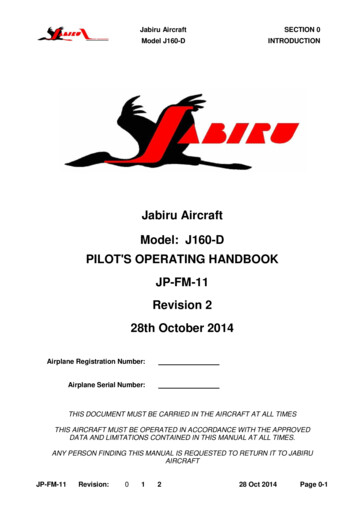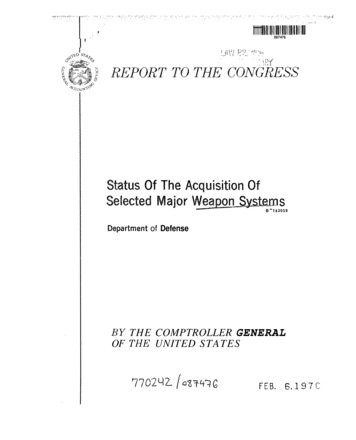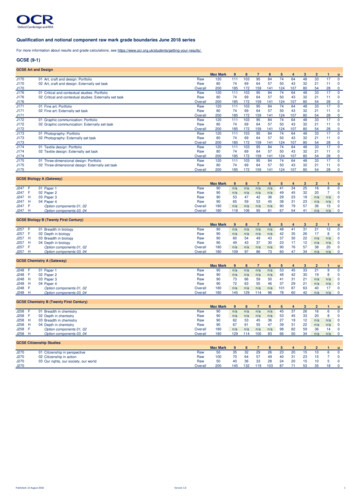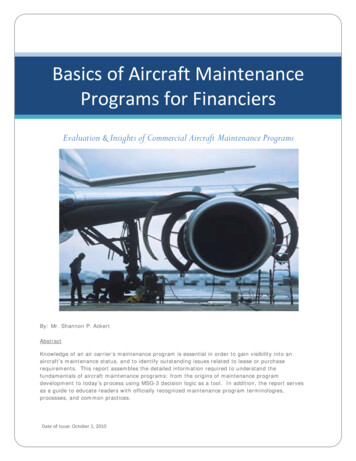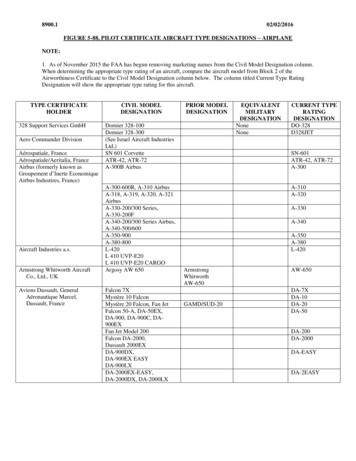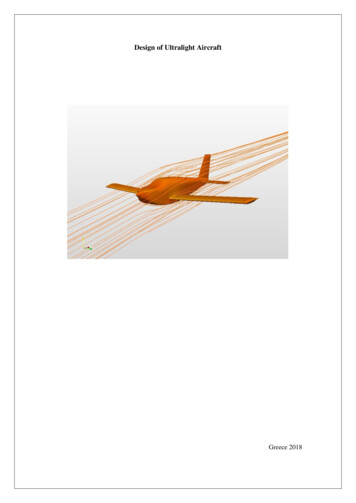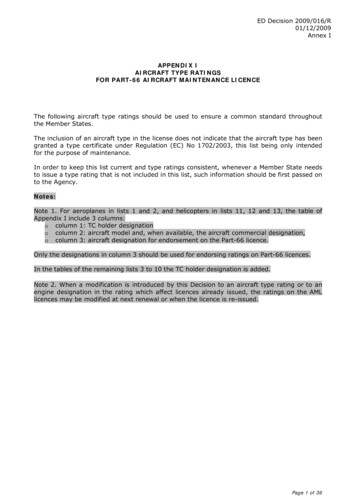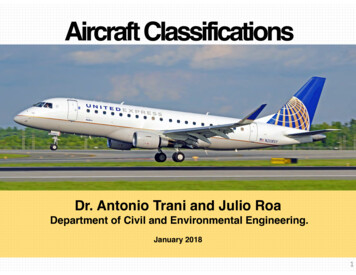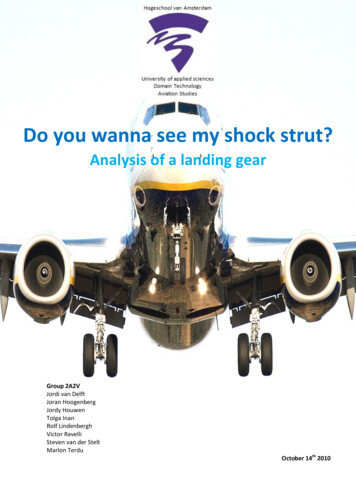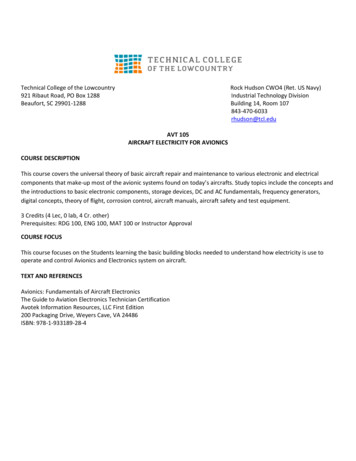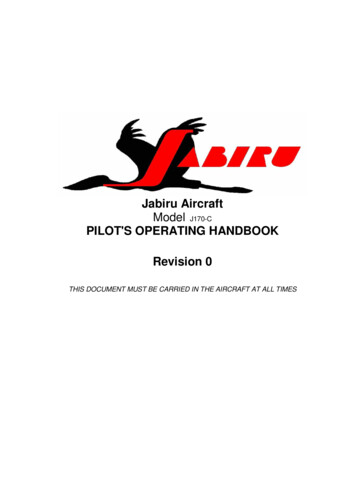
Transcription
Jabiru AircraftModel J170-CPILOT'S OPERATING HANDBOOKRevision 0THIS DOCUMENT MUST BE CARRIED IN THE AIRCRAFT AT ALL TIMES
Jabiru AircraftPilot Operating HandbookModel J170-CAIRCRAFT PARTICULARSTHIS AIRCRAFT MUST BE OPERATED IN ACCORDANCE WITH THE APPROVEDDATA AND LIMITATIONS CONTAINED IN THIS MANUAL AT ALL TIMES.Registration Marks:Manufacturer:Aircraft Serial Number:Certification Categories:Jabiru Aircraft Pty LtdLight Sport AircraftAny person finding this Manual is requested to return it to Jabiru AircraftJP-FM-08Revision:03 April 2007Page 2
Jabiru AircraftPilot Operating HandbookModel J170-CAMENDMENT RECORD :0Affected PagesDateInserted3 April 2007SignaturePage 3
Jabiru AircraftPilot Operating HandbookModel J170-CINTRODUCTIONThis Operating Handbook has been prepared to comply with the requirements of ASTM F2245.This Operating Handbook includes the information required of the Flight Training Supplement.The basic handbook provides all the information, procedures and limitations required tooperate the aircraft as a Light Sport Aircraft. Information, procedures and limitationsrelating specifically to other operations are provided in the appropriate supplement.The operating procedures presented herein are the result of Jabiru Aircraft’s knowledge andexperience gained up to the date of issue or amendment of this handbook. The handbook is notintended to be a guide for basic flight instruction or as a training manual. It may be used foroperational purposes only if kept in a fully amended state. It contains all the informationconsidered necessary to safely operate the aircraft.The operator must be thoroughly familiar with the aircraft and the contents of this handbookbefore initial operation. Thereafter the handbook should be reviewed periodically to enable theoperator to maintain the highest level of familiarity with the aircraft, its controls and recommendedoperating procedures.Pilot’s Operating Handbook (POH)The handbook is valid only for the particular aircraft identified on the AIRCRAFTPARTICULARS page, and unless subsequently amended, refers to the aircraft as originallydelivered from the factory. The handbook consists of the following:Basic POHThe basic POH provides all required details of the standard aircraft and the procedures requiredto operate it in the LSA category. Apart from the listing in Section 4, no other details of anyoptional equipment fitted at the factory will be found in the basic POH. Refer to the relevantsupplement.SupplementsSelf contained supplements are provided in SECTION 10 of the POH to provide details andprocedures associated with the fitment of specified optional and special purpose equipment.AmendmentsAny amendments to any page of the POH is to have an amendment date. All amendments areto be incorporated as soon as possible after their receipt and details entered into the appropriateamendment record sheet.JP-FM-08Revision:03 April 2007Page 4
Jabiru AircraftPilot Operating HandbookModel J170-CWARNINGS, CAUTIONS & NOTESDefinitions used in the POH such as WARNING, CAUTION, NOTE are employed in the followingcontext:WARNINGOperating procedures, techniques, etc. which if not followed correctly, may result in personalinjury or death.CAUTIONOperating procedures, techniques, etc. which if not strictly observed, may result in damage to theaircraft or to its installed equipment.NOTEOperating procedures, techniques, etc. which it is considered essential to highlight.JP-FM-08Revision:03 April 2007Page 5
Jabiru AircraftPilot Operating HandbookModel J170-CTHREE-VIEW DRAWINGFigure 1-1 Three View Drawing of the J170-CNote: All dimensions in millimetresJP-FM-08Revision:03 April 2007Page 6
Jabiru AircraftPilot Operating HandbookModel J170-CSYMBOLS, ABBREVIATIONS AND TERMINOLOGYGeneral Symbols and AbbreviationsAAGLAMSLAVGASBHPCASACAOCAR CCHTcmDCFAA FFARftft/mingGalhPaHFICAOIFRIMCinin Hgin lbsISAkgkg/lkHzkts, bove Ground LevelAbove Mean Sea LevelAviation GasolineBrake Horse PowerCivil Aviation Safety Authority (Australia)Civil Aviation Order (Australia)Civil Aviation Regulation (Australia)Degrees CelsiusCylinder Head TemperatureCentimetre, centimetresDirect CurrentFederal Aviation Administration (USA)Degrees FahrenheitFederal Aviation Regulation (USA)Foot, feetFeet per minuteAcceleration due to gravityGallonHectopascal, hectopascalsHigh FrequencyInternational Civil Aviation OrganisationInstrument Flight RulesInstrument Meteorological ConditionsInch, inchesInches of mercuryInch poundsInternational Standard AtmosphereKilogramKilogram per litreKilohertzKnotsKilopascalsKilowatt, kilowattsLitre, litresPound, poundsLeft handLeft hand sideMetreSquare metreCubic metreMilli ampereMean Aerodynamic ChordMaximumMegahertzMillimetreMinimum or minuteRevision:03 April 2007Page 7
Jabiru AircraftPilot Operating HandbookModel ecSQSTBYTBOT/OU/SUSGUS GalVVFRVHFVMCAutomotive FuelNautical mile, nautical milesOutside Air TemperaturePassengerPilots Operating HandbookPropellerPounds per square inchQuantityQuartsRight HandRight Hand SideFuel Octane Rating Scale (Research Octane Number)Revolutions per minuteSociety of Automotive EngineersSecondsSquareStandbyTime between overhaulsTake OffUnserviceableUS GallonUS GallonVoltsVisual Flight RulesVery High FrequencyVisual Meteorological ConditionsGeneral Airspeed Terminology and Symbols CASCalibrated Airspeed: the indicated speed of an aircraft corrected for positionand instrument error. Calibrated airspeed is equal to true airspeed instandard atmosphere at sea level. KCAS:Calibrated Airspeed expressed in knots. IASIndicated Airspeed: the speed of an aircraft as shown on the airspeedindicator. IAS values in this manual assume zero instrument error. KIASIndicated Airspeed expressed in knots. TASTrue Air Speed: the airspeed of an aircraft relative to the undisturbed airthrough which it passes. T.O.S.STake-Off Safety Speed: the airspeed chosen to ensure that adequate controlwill exist under all conditions, including turbulence and sudden and completeengine failure during the climb after take-off. It is the speed required at 50feet. VAManoeuvring Speed: the maximum speed at which application of fullavailable aerodynamic control will not damage or overstress the aircraft.JP-FM-08Revision:03 April 2007Page 8
Jabiru AircraftPilot Operating HandbookModel J170-C VFEMaximum Flap Extended Speed: the highest speed permissible with wingflaps in a prescribed extended position. VNENever Exceed Speed: the limiting airspeed that may not be exceeded at anytime. VCMaximum Structural Cruising Speed: the speed that should not be exceededexcept in smooth air and then only with caution. VSStalling Speed: or the minimum steady flight speed at which the aircraft iscontrollable. VSOStalling Speed: or the minimum steady flight speed at which the aircraft iscontrollable in the landing configuration. VXBest Angle-of-Climb Speed: the airspeed which delivers the greatest gain ofaltitude in the shortest possible horizontal distance. VYBest Rate-of-Climb Speed: the airspeed which delivers the greatest gain inaltitude in the shortest possible time.Meteorological Terminology OAT – Outside Air Temperature – the outside free air static temperature. Airfield Pressure Height – The height registered at the surface of an aerodrome by analtimeter with the pressure sub-scale set to 1013 hPa (29.92 inches Hg). Pressure Altitude – Altitude measured from standard sea-level pressure (1013 hPa/29.92inches Hg) by a pressure or barometric altimeter corrected for position and instrument error. Indicated Pressure Altitude – the altitude actually read from an altimeter when thepressure barometric sub-scale has been set to 1013 hPa (29.92 inches Hg). QNH – The local pressure setting that if set on the subscale of an altimeter will cause thealtimeter to indicate local altitude above mean sea level. Wind – The wind velocities to be used as variables on aircraft performance are to beunderstood as the headwind or tail wind components of the reported winds.Aircraft Performance and Flight Planning Terminology Climb Gradient – The ratio of the change in height during a climb, to the horizontaldistance travelled. Demonstrated Crosswind Component – The crosswind component, during take-off andlanding, for which adequate control of aircraft was actually demonstrated during certificationtests.JP-FM-08Revision:03 April 2007Page 9
Jabiru AircraftPilot Operating HandbookModel J170-CWeight and Balance Terminology Datum – An imaginary vertical plane from which all horizontal distances are measured forbalance purposes. Station – A location along the aircraft fuselage usually given in terms of distance from thereference datum. Arm – The horizontal distance from the reference datum to the centre of gravity (C of G) ofan item. Moment – The product of the weight of an item multiplied by its arm. Index Unit – Moment divided by a constant. Used to simplify balance calculations byreducing the number of digits. Centre of Gravity (C of G) – The point at which an aircraft would balance if suspended.The distance from the C of G to the reference datum can be found by dividing the totalmoment by the total weight of the aircraft. C of G Arm – The arm obtained by adding the aircraft's individual moments and dividingthe sum by the total weight. C of G Limits – The extreme centre of gravity locations within which the aircraft must beoperated at a given weight. Useable Fuel – The quantity of fuel available for flight planning purposes. Unusable Fuel – The quantity of fuel (determined under adverse fuel flow conditions) thatis not available for flight. Empty Weight – Weight of aircraft with unusable fuel and full oil. Useful Load – Difference between take-off weight, and basic empty weight. Maximum Take-Off Weight – Maximum weight approved for take-off. Maximum Landing Weight – Maximum weight approved for the landing. Header Tank – Fuel tank plumbed between the wing tanks and the engine. Also known asCollector Tank or Sump Tank.JP-FM-08Revision:03 April 2007Page 10
Jabiru AircraftPilot Operating HandbookModel J170-CUSE OF METRIC/IMPERIAL UNITSThis POH uses the metric system as the basic system of measurement. Where common usageor available instrumentation refer to the Imperial/US unit system, both units are quoted. Thefollowing conversion factors are presented as a ready reference to the conversion factors thathave been used in this manual as well as supplying some others that may be found useful.1 Pound (lb)1 Pound per sq in (psi)1 Inch (in)1 Foot (ft)1 Statute mile1 Nautical mile (NM)1 Millibar (mb)1 Millibar (mb)1 Imperial gallon1 US gallon1 US quart1 Cubic foot (ft3)1 Acre1 Degree Fahrenheit (ΕF)1 Inch Pound (in lb)1 Foot Pound (ft lb)JP-FM-08Revision:0 0.4536 Kilogram (kg)6.895 Kilopascal (kPa)25.4 Millimetres (mm)0.3048 Metre (m)1.609 Kilometres (km)1.852 Kilometres (km)1 Hectopascal (hPa)0.1 Kilopascal (kPa)4.546 Litres (l)3.785 Litres (l)0.946 Litre (l)28.317 Litres (l)0.4047 Hectares[1.8 x ΕC] 320.113 Newton Metres (Nm)1.356 Newton Metres (Nm)3 April 2007Page 11
Jabiru AircraftPilot Operating HandbookModel J170-CTABLE OF CONTENTSParagraph1Page1.11.11.21.3GENERAL INFORMATION.14MANUFACTURERS STATEMENT OF COMPLIANCE.14MANUFACTURER DETAILS .15LIGHT SPORT AIRCRAFT NOTIFICATION .15J170-C PERFORMANCE & SPECIFICATION SUMMARY .152.12.22.32.42.52.6AIRPLANE AND SYSTEMS DESCRIPTIONS .16ENGINE.16PROPELLER .16FUEL .16ENGINE OIL .16OPERATING WEIGHTS AND LOADING.16MINIMUM EQUIPMENT LIST.1723OPERATING LIMITATIONS .193.1KINDS OF OPERATION .193.2AIRSPEED LIMITS .193.3CROSSWIND .193.4AIRCRAFT SERVICE CEILING.193.5LOAD FACTORS .193.6PROHIBITED MANOEUVRES .203.7POWERPLANT LIMITATIONS .203.7.1Fuel Grade.203.7.2Lubricating Oil.213.8POWERPLANT INSTRUMENT MARKINGS .213.9EFIS & EMS LIMITATIONS DISPLAY.213.9.1Required EFIS limitation displays:.213.9.2Required EMS Displays: .213.10POWER GENERATION SYSTEM LIMITATIONS.223.11OTHER LIMITATIONS.223.12PLACARDS .223.12.1Cockpit Placards General .223.12.2Cockpit Controls .243.12.3External Fuselage.254WEIGHT AND BALANCE INFORMATION.274.1CG RANGE.274.2BAGGAGE ZONES.284.3AIRCRAFT WEIGHT DATA.294.4TRIM SHEETS.324.4.1Calculate Aircraft Weights .324.4.2Calculating the Operating CG Locations .334.4.3Allowable Loading Conditions .3355.15.25.35.4PERFORMANCE.36TAKE OFF AND LANDING DISTANCES.36RATE OF CLIMB.36CRUISE SPEEDS / RPM / FUEL CONSUMPTION .36AIRSPEED INDICATOR SYSTEM CALIBRATION .376.1EMERGENCY PROCEDURES .38AIRSPEEDS FOR EMERGENCY OPERATIONS.386JP-FM-08Revision:03 April 2007Page 12
Jabiru AircraftPilot Operating HandbookModel J170-C6.2EMERGENCY PROCEDURES CHECK LISTS. 386.2.1Engine Failures . 386.2.2Airstart & Limitations . 396.2.3Forced Landings . 406.2.4Fires. 406.2.5Carburettor Icing . 426.2.6Fuel Low Pressure Warning Light Illuminates Continuously. 426.2.7Landing With a Flat Main Tyre. 426.2.8Inadvertent Icing Encounter. 426.2.9Electrical Power Supply System Malfunctions . 426.2.10Spins . 437NORMAL PROCEDURES . 447.1GENERAL. 447.2SPEEDS FOR NORMAL OPERATION. 447.3BEST ANGLE OF CLIMB SPEED. 447.4BEST RATE OF CLIMB SPEED . 447.5PREFLIGHT INSPECTION. 457.6NORMAL PROCEDURES CHECK LISTS . 487.6.1Before Starting Engine . 487.6.2Starting Engine - Cold . 487.6.3Before Take-Off. 487.6.4Take-Off . 497.6.5Initial Climb . 497.6.6Cruise . 497.6.7Descent. 497.6.8Before Landing (and flight below 1000ft AGL) . 497.6.9Landing . 497.6.10Baulked Landing . 507.6.11After Landing/Securing . 507.6.12Short Field Take-Off . 507.6.13Short Field Landing. 507.6.14Engine Management – Ground Running . 518AIRCRAFT GROUND HANDLING AND SERVICING . 528.1FUEL. 528.2OIL . 528.2.1Engine Oil Specification:. 528.2.2Engine Oil Viscosity Grade:. 528.3BRAKES . 539CLIMATIC RESTRICTIONS. 5410SUPPLEMENTS . 5510.1LOG OF SUPPLEMENTS – JABIRU AIRCRAFT SUPPLEMENTS. 56JP-FM-08Revision:03 April 2007Page 13
Jabiru AircraftPilot Operating HandbookModel J170-C1GENERAL INFORMATION1.1 MANUFACTURERS STATEMENT OF COMPLIANCEINSERT COPY OF MANUFACTURERS STATEMENT OF COMPLIANCEJP-FM-08Revision:03 April 2007Page 14
Jabiru AircraftPilot Operating HandbookModel J170-C1.1 MANUFACTURER DETAILSJabiru Aircraft P/LPO Box 5186Bundaberg West,QLD 4670Phone: 07 4155 1778Fax: 07 4155 2669Email: info@jabiru.net.auStreet Address:Jabiru AircraftAirport Drive, Hinkler AirportBundabergQLD 46701.2 LIGHT SPORT AIRCRAFT NOTIFICATIONThere are inherent risks in the participation in recreational aviation aircraft. Operators andpassengers of recreational aviation aircraft, by participation, accept the risks inherent in suchparticipation of which the ordinary prudent person is or should be aware. Pilots and passengershave a duty to exercise good judgment and act in a responsible manner while using the aircraftand to obey all oral or written warnings, or both, prior to or during use of the aircraft, or both.1.3 J170-C PERFORMANCE & SPECIFICATION SUMMARYGross Weight600kg (1323 lb)Top Speed at Sea Level120 KCASFull Fuel Range770nm at 75% power1030 nm at most efficient power settingRate of Climb at Sea Level2550 fpm1Take-Off Distance475 mLanding Distance468 mStall Speed Clean45 KCASStall Speed Flaps Full Down40 KCASFuel Capacity135 L UseableApproved FuelsAVGAS or MOGAS with RON of 95 or higher.Maximum Engine Power80 hp @ 3300 RPM.Refer to the main body of this handbook below for more information.12Range with 45 minute reserve at stated power settingAt Gross Weight, ICAO Standard AtmosphereJP-FM-08Revision:03 April 2007Page 15
Jabiru AircraftPilot Operating HandbookModel J170-C2AIRPLANE AND SYSTEMS DESCRIPTIONS2.1 ENGINEManufacturer:Model:Jabiru Aircraft Pty Ltd2200B2.2 PROPELLERManufacturer:Model:Type:Number of blades:Diameter:PitchMax RPM:Jabiru Aircraft Pty LtdC000262-D60P42Wooden, Fixed Pitch21524 mm (60 in)1067 mm (42 in)33002.3 FUELCapacity:Grade:135L Total Useable (2 OFF 67.5L Wing Tanks)Avgas 100LLAvgas 100/130MOGAS with minimum Octane Rating of 95 RON may be used.Refer to Section 3 for additional details.2.4 ENGINE OILJabiru Aircraft approves lubricating oils of any brand name conforming to specifications MIL-L6082 for straight mineral oil and MIL-L-22851 for ashless dispersant oil.Refer to Section 3 for additional details.2.5 OPERATING WEIGHTS AND LOADINGMax Take-Off & Landing Weight:600 kg (1323 lb)Maximum Baggage18kg behind each seat – 36kg total180-mm (7.09”, 18.2%MAC) aft of datum up to & including440 kg (970lb)Forward Limit:255-mm (10.0”, 25.8%MAC) aft of datum at 600kg(1323lb)Linear variation between points.Aft Limit287-mm (11.3”, 29.0%) aft of datum at all weightsDatumWing Leading EdgeLevelling MeansLongitudinalJP-FM-08Spirit Level placed on the lower section of the door framesRevision:03 April 2007Page 16
Jabiru AircraftPilot Operating HandbookModel J170-C(left or right side).Spirit Level placed across the fuselage between the leftand right side lower door frames.LateralArmsArm for Front Seat Station297-mm aft of datumArm for Baggage On Shelf920-mm aft of datumFuel Station451-mm aft of datumRefer to Section 4 for additional details.2.6 MINIMUM EQUIPMENT LISTSystem Instruments and/orEquipmentVFRDayRemarksA/RAs required per localoperating regulationsCommunicationsVHF CommElectrical PowerAlternator1Battery1Voltage Indicator1Fire ProtectionPortable Fire ExtinguisherA/RAs required per localoperating regulationsFlight ControlsPitch Trim Indicator1Pitch Trim System1Flap Position Indicator1Stall Warning System1FuelJP-FM-08Revision:03 April 2007Page 17
Jabiru AircraftPilot Operating HandbookModel J170-CSystem Instruments and/orEquipmentVFRDayFuel Quantity Indicator2Fuel On/Off Valve1RemarksIce & Rain ProtectionEngine Alternate Air InductionSystem1Navigation & Pitot StaticAltimeter1Airspeed Indicator1Magnetic Compass1Time Piece1Turn Co-ordinatorA/RPitot/Static System1TransponderA/RMay be carried on thepilotAs required per localoperating regulationsAs required per localoperating regulationsEngine IndicatingJP-FM-08Cylinder Head Temperature1Tachometer1Oil Pressure1Oil Temperature1Fuel Pressure1Oil Quantity (Dip Stick)1Caution Warning System1Approved Pilot’s OperatingHandbook1Revision:0Fuel, electrical, andvacuum systems3 April 2007Page 18
Jabiru AircraftPilot Operating HandbookModel J170-C3OPERATING LIMITATIONS3.1 KINDS OF OPERATIONThe standard J170-C, as detailed within this POH, is approved for Day VFR Operations only.An optional package is available to allow the aircraft to conduct Night VFR Operations.Physically this package consists of additional lights and equipment. Aircraft approved for NightVFR Operations must also have such operations approved on their Certificate of Airworthinessand must carry the Jabiru J170-C Night VFR Operations Supplement (Document Number JPMS-05).NoteCarrying out Night VFR Operations without a valid Certificate of Airworthiness, Night VFRSupplement & properly equipped aircraft is illegal. Pilots must ensure the aircraft isappropriate for the intended operations.3.2 AIRSPEED LIMITSSPEEDMax Manoeuvring Speed (VA)KCASREMARKS90Do not make full or abrupt controlmovements above this speed.Do not exceed this speed in anyoperation.Do not exceed this speed except insmooth air and then with caution.Do not exceed this speed with the flapsdeployed.Never Exceed Speed (VNE)140Max Structural Cruising Speed (VC)108Maximum Flap Extension Speed (VFE)80Stalling Speed (VS)45in Cruise ConfigurationStalling Speed (VS0)40in Landing ConfigurationNote: Refer to Section 5.4 for Indicated Airspeed limitations.3.3 CROSSWINDThe maximum allowable crosswind velocity is dependant on pilot capability as well as aircraftlimitations. With average pilot technique, direct crosswinds of 14 knots can be handled withsafety.3.4 AIRCRAFT SERVICE CEILING10 000 feet ASL.3.5 LOAD FACTORSFlap itive 4g 4g 2.0gNegative-2g-2-g0g3 April 2007Page 19
Jabiru AircraftPilot Operating HandbookModel J170-C3.6 PROHIBITED MANOEUVRESManoeuvres in the course of normal flying are approved.Stalls may be carried out at bank angles of up to 60 .All aerobatic manoeuvres including spins are prohibited.3.7 POWERPLANT LIMITATIONSAbsoluteLimitsContinuousLimitsLimits ForGroundRunningMaximumTake-Off(80 BHP)MaximumCont(80 BHP)N/ARPMPOWERMaximumTemperaturesCylHeadOil PressureLimitsMinMaxMinMax118 C(244 F)5 kPa(0.75psi)20 kPa(3psi)220 kPa(31 psi)525 kPa(76psi)180 C(356 F)100 C(212 F)5 kPa(0.75psi)20 kPa(3psi)220 kPa(31 psi)525 kPa(76 psi)180 C(356 F)(Note #2)100 C(212 F)(Note #2)5 kPa(0.75psi)20 kPa(3psi)80 kPa(11 psi)525 kPa(76 psi)3300200 C(392 F)(Note #1)3300N/AOilFuel PressureLimitsNote #1 Time with CHT at between 180 C and 200 C is not to exceed 5 MinutesNote #2 If temperature limits are reached, shut the engine down or cool it by pointing theaircraft into wind.Other limits are as follows: Minimum oil pressure at idle: Maximum oil pressure at start:80 kPa (11 psi)525 kPa (76 psi)3.7.1Fuel Grade Avgas 100LL Avgas 100/130 MOGAS with minimum Octane Rating of 95 RON may be used. Do not use fuel additives such as Octane Boosters.NOTEAs there are significant variations possible even between automotive fuels with the same valuesof RON, Jabiru Aircraft strongly recommend using AVGAS. Automotive fuels should only beused where AVGAS is not available, and if used, must have the highest anti-detonation ratingpractically available.CAUTIONFuel additives containing alcohol (i.e. Ethanol etc) will damage the sealant used in the fuel tanks.DO NOT use MOGAS with any level of added alcohol.JP-FM-08Revision:03 April 2007Page 20
Jabiru AircraftPilot Operating HandbookModel J170-C3.7.2Lubricating OilOil Capacity 2.3 Litres.Refer to Section 8.2 for additional details.3.8 POWERPLANT INSTRUMENT MARKINGSInstrumentRed LineMinimum LimitGreen ArcNormalOperatingRed Arc/LineMaximum LimitYellow ArcPrecautionaryRangeTachometer--3300 RPM-Cylinder HeadTemperature-Up to 180 C(356 F)200 C(392 F)180 C - 200 C(356 - 392 F)Oil Pressure80 kPa(11 psi)220 - 525 kPa(31 – 76 psi)525 kPa(76 psi)80 - 220 kPa(11- 31psi)Oil Temperature15 C(59 F)80 - 100 C(176 - 212 F)118 C(244 F)100 C - 118 C(212 - 244 F)Fuel Pressure5 kPa(0.75psi)5 – 20 kPa(0.75 – 3 psi)20 kPa3 psi-Voltage-10.5 – 15 Volts--3.9EFIS & EMS LIMI
Jabiru Aircraft Pilot Operating Handbook Model J170-C JP-FM-08 Revision: 0 3 April 2007 Page 4 INTRODUCTION This Operating Handbook has been prepared to comply with the requirements of ASTM F2245. This Operating Handbook includes the information required of the Flight Training Supplement.
